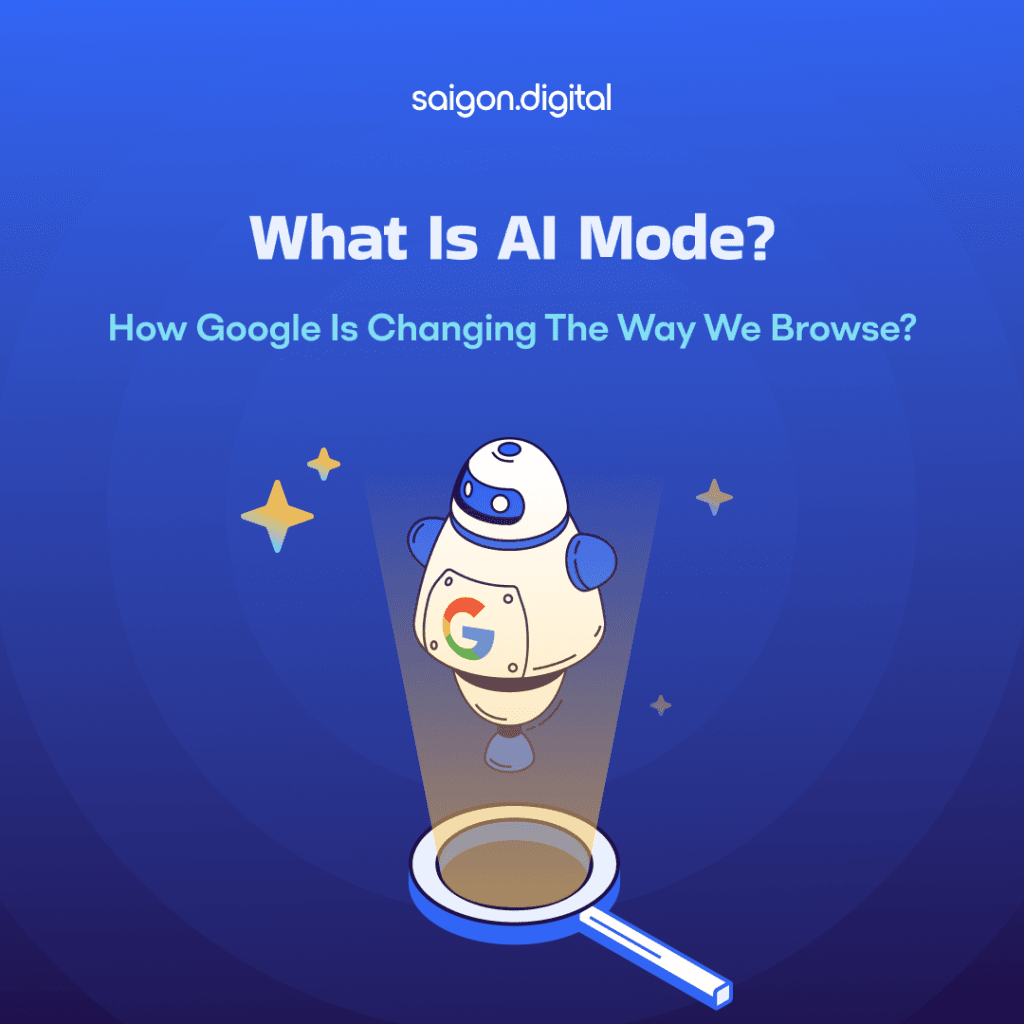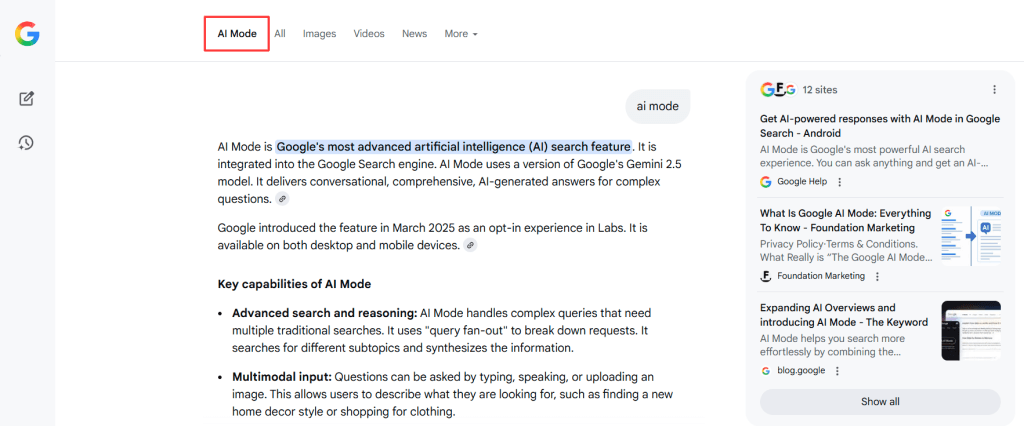
Understanding AI Mode: The Basics
AI Mode is an interactive search experience powered by Google's Gemini model, designed to help users explore topics in a more comprehensive, personalised, and intuitive way. Unlike AI Overviews , which surface on select queries within the traditional Google results, AI Mode appears as a dedicated tab that users can actively choose to engage with. In AI Mode, users can:Ask More Complex or Open-Ended Questions
Traditional search tends to cater to straightforward queries like "best laptops 2025." But AI Mode is built for nuanced, multi-layered questions, such as “Which laptop is best for graphic design students under $1000 with long battery life?” It can handle the depth and reasoning required to interpret, structure, and respond to these compound inquiries with contextually rich information .Follow Up With Additional Questions in A Conversational Flow
In AI Mode, you don’t have to start from scratch with every query. You can ask a follow up question like “Is that model good for video editing?” and Google will remember the context from your previous question. This mimics a human conversation, allowing users to refine their information journey naturally.Submit Queries Using Text, Voice, or Images
AI Mode introduces multimodal search. That means users can speak a question, type it, or even upload a photo (e.g. of a product or a plant) and ask, “What is this?” or “Where can I buy this?” This broadens accessibility and real-world use, especially for visual learners and mobile users .Receive AI-Generated Responses Accompanied by Rich Web Links
Instead of the usual 10 blue links, AI Mode gives you a summarised, structured answer with embedded links to relevant sources, letting you go deeper where needed. These links often lead to websites that Google determines are authoritative, accurate, and helpful, which increases the stakes for SEO. This new experience signals a paradigm shift in how information is discovered, consumed, and acted upon in the new dawn of technology in 2025.How Google’s AI Mode Works
At the core of AI Mode is Gemini, a custom multimodal language model that Google uses to interpret and respond to user intent. The system issues multiple sub-queries concurrently across different topics and data sources, a technique known as query fan-out. It then synthesises this information into a comprehensive AI-generated response, complete with supporting links, shopping data, and factual insights from the Google Knowledge Graph.
Multimodal Input
AI Mode accepts not only written and spoken queries but also images. This is a major shift. For instance, users can snap a photo of a damaged appliance part and ask, “How do I fix this?” The system analyses the image and context to deliver a helpful, visual-rich response. Businesses with strongvisual SEO
strategies (e.g. alt text, image schema, rich product photos) can now get featured more prominently.Context Retention
Google’s AI Mode remembers the intent and topic across multiple questions. This is different from traditional search, which treats each query independently. Marketers should start structuring their content for sequential discovery, anticipating follow-up queries and linking internally to relevant answers.Advanced Reasoning
Unlike keyword-matching systems, AI Mode understands semantic relationships and can handle multi-step queries. For example: “Compare electric vs petrol cars, and which one is better for cold weather.” The system doesn’t just retrieve two pages, it compares and contrasts across multiple trusted sources, then generates a reasoned conclusion.Visual Results
AI Mode prioritises rich media when it adds value. For example, asking “how to tie a tie” would result in images or videos, not just text. Websites that provide high-quality visuals and video content, complete with metadata and captions, are far more likely to appear here. In early testing, Google found that users asked twice as long queries in AI Mode than in traditional search. That indicates a more exploratory intent, where users are seeking not just answers, but understanding.AI Mode vs. AI Overviews: What’s the Difference?
Feature AI Overviews AI Mode Appearance Inline within traditional Search Separate tab Triggering Only on eligible queries User opt-in Follow-up support Limited Full conversation context Input types Text only Text, voice, image Depth of reasoning Moderate Advanced Use case Quick summaries Exploratory researchWhat Does AI Mode Mean for SEO?
The rise of AI Mode introduces a set of new SEO dynamics that specialists must understand and adapt to. Here’s how:Your Content Needs to Be AI-Ready
AI Mode relies on quality web content to inform its responses. Pages with clear structure, semantic markup, and rich media are more likely to be cited by the model. That means:- Use Schema Markup: Implementing schema helps Google understand the structure of your content. Structured data like FAQPage, HowTo, Product, and Recipe schemas allow AI to parse and cite your content directly. Without schema, even great content might get overlooked.
- Implement FAQ, How-to, and Review structured data: These schemas make your content eligible for rich snippets and AI Overview citations. Google looks for content that answers questions succinctly and accurately, having your FAQs marked up correctly increases your chances of being featured.
- Optimise page load speed and mobile-friendliness: If your page takes too long to load or doesn’t render well on smaller screens, Google may avoid linking to it in AI Mode results. Use SEO tools like PageSpeed Insights and Google Search Console to check Core Web Vitals as well as audit and optimise your performance.
Topical Authority Matters More Than Ever
AI Mode pulls from multiple quality sources to validate information. Sites that publish in-depth content on niche topics, consistently and accurately (that are also in line with the industry they operate), will stand out. This way, businesses not only build topical authority through content but also elevate their brand authority .Optimise for Conversations, Not Just Keywords
AI Mode is meant to respond to users’ query with conversational answers. So instead of focusing only on keyword density, consider:- Writing in natural language: Write how people talk, not just how search engines index. AI Mode interprets conversational input like “What are the pros and cons of solar panels in rainy cities?” Make sure your content anticipates such phrasing.
- Answering related questions within the same content: Instead of creating multiple short pages, build pillar content that answers core questions and includes subheadings for related queries. This structure helps Google understand the intent tree of your content and group it contextually in responses.
- Including long-tail phrases and follow up style subheadings: Use headings like “Can I install solar panels without sunlight?” or “What’s the ROI of solar energy in Southeast Asia?” These long-tail, conversational queries map directly to how people search and could increase your visibility.
Engagement Metrics Will Influence Visibility
With Google tracking user satisfaction, pages that drive longer time-on-site, more interactions, and fewer bounces are likely to see better visibility in AI Mode link selections.How to Optimise for Google’s AI Mode
Want to future-proof your content? Here’s a quick roadmap to get started:Update Old Content
Refresh your evergreen content with updated facts, visuals, internal links, and FAQs. Make sure the format aligns with conversational readability.Use Rich Snippets and Structured Data
Add schema for How-To, Product, Review, and FAQ sections. This improves your chances of being selected in AI-generated responses.Strengthen E-E-A-T Signals
Google continues to evaluate websites’ E-E-A-T signals (Experience, Expertise, Authoritativeness, and Trustworthiness). Make sure to include author bios, cite sources, link to authoritative references, and display user reviews when possible.Embrace Visual Content
Incorporate infographics, diagrams, and videos that explain complex topics clearly. AI Mode prefers visual responses when they aid understanding.Monitor Performance in Search Console
Pay attention to changes in impressions, CTR, and referring URLs. As the technology evolves, these metrics will evolve, and may point to new optimisation opportunities.When Will AI Mode Roll Out Fully?
As of May 2025, AI Mode is available as a tab within Google Search or directly at google.com/aimode. It’s also accessible via the Google app by tapping the magnifying glass icon. Google has indicated that its technology will continue to evolve, introducing new features, expanding to more queries, and eventually influencing the core Search experience.Adapt Now, Not Later
Google’s AI Mode isn’t just a new feature. It’s a signpost pointing to where search is headed, towards smarter, more helpful, and more human-like interactions with information. For SEO professionals, marketers, and content creators, this is both a challenge and an opportunity. The brands that thrive in the age of AI will be those that prioritise content quality, embrace user-centric design, and adopt conversational strategies that meet users where they are.Work With a Digital Partner Who Gets It
At Saigon Digital , we stay ahead of the curve so you don’t have to. From technical SEO audits to conversational content strategies, we help brands adapt to the evolving search landscape, including AI Mode and beyond. Contact Saigon Digital today for an AI-ready SEO strategy tailored to your brand.Frequently Asked Questions
1. What is AI Mode in Google Search?
AI Mode is a new feature in Google Search that provides AI-powered, conversational responses to user queries. Built on Google’s Gemini model, it allows users to ask complex or open-ended questions and receive rich, contextual answers supported by high-quality links from the web. It’s available as a dedicated tab in Search or directly at google.com/aimode, offering an experience designed for deeper exploration and follow-up questions.2. How is AI Mode different from AI Overviews?
While both use generative AI, AI Mode is a more advanced and interactive experience. AI Overviews appear within traditional search results and are triggered automatically on certain queries. AI Mode, on the other hand, lives in a separate tab that users can opt into, supports multimodal inputs (text, voice, images), retains context between questions, and handles more complex, reasoning-heavy tasks like product comparisons, trip planning, or how-to guides.3. Does AI Mode affect how websites appear in search results?
Yes. AI Mode changes how information is retrieved and presented by prioritising contextually relevant, authoritative content. Websites featured in AI responses are typically those that offer high-quality, structured, and well-optimised content. Rich media, schema markup, and strong topical authority all increase a page’s chances of being cited or linked in AI responses.4. How can I optimise my content for AI Mode?
To increase your chances of being featured:- Use structured data (FAQ, How-to, Product schema)
- Write in a natural, conversational tone
- Create in-depth, topical content with clear subheadings
- Include visuals, videos, and up-to-date information
- Focus on user engagement (time on site, micro-conversions)





